The movement predates his arrival, but on a sunny Sunday in September, with the wave of relational aesthetics breaking against the rocky Malibu cliffs beneath his feet, the director of the Museum of Contemporary Art Jeffrey Deitch powerfully proclaimed his institution’s support for the Gala-as-Art.
For the benefit of those who are too poor, cheap, uninfluential, or uninvitable, here is a brief look at the genre. But first a little context:
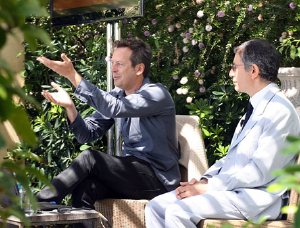 Doug Aitken was speaking at MoCA’s “Salons by the Shore,” a brunch series conceived and organized by trustee [and Gala co-chair] Lilly Tartikoff Karatz, which was held in a location that saves trustees from having to schlep all the way downtown on the weekend: the 5-acre Malibu home of [fellow co-chair] Nancy and Howard Marks. The artist presented a history of his work, which Jeffrey Deitch bracketed with discussions about Aitken’s plans for his “commission” to create a “social sculpture,” i.e., the 31st Annual Gala. On their blog, MoCA calls this work, The Artist’s Museum Happening, but The Art Newspaper reports it “will be an immersive project called We.”
Doug Aitken was speaking at MoCA’s “Salons by the Shore,” a brunch series conceived and organized by trustee [and Gala co-chair] Lilly Tartikoff Karatz, which was held in a location that saves trustees from having to schlep all the way downtown on the weekend: the 5-acre Malibu home of [fellow co-chair] Nancy and Howard Marks. The artist presented a history of his work, which Jeffrey Deitch bracketed with discussions about Aitken’s plans for his “commission” to create a “social sculpture,” i.e., the 31st Annual Gala. On their blog, MoCA calls this work, The Artist’s Museum Happening, but The Art Newspaper reports it “will be an immersive project called We.”
Galas. The conventions and codes of the charity gala are long-established and provide many occasions for reflection and interpretation: committees; giant tents; decorations; hors d’oeuvres and cocktails; ten-person tables positioned according to price; elaborate centerpieces; agonized-over food; a chain of congratulatory speeches; entertainment; dancing; favors and gift bags; armies of temporary staff.
These elements become familiar to regular galagoers. [I confess, I’m an inveterate museum gala attendee and sometime committee member, primarily in New York.] Sometimes that familiarity can breed, if not contempt, then perhaps a little disappointment, weariness, or sniffy ennui. Or it can provide comfort, a sense of stability, and continuity. The calendar is full of galas, and any number of worthy causes must compete, not necessarily for money, but for the time, attention, and enthusiasm of the donor population. And so benefit committees and event chairs are deeply attuned to the nuances and details of their gala. From long experience, they know what works, what doesn’t, what sticks in the memory, and what loosens the pursestrings even further.
It’s an elaborate social ritual where very rich people gather to celebrate their success, their status, their society, their taste, their generosity–and their passion for whatever deeply important and worthy endeavor is being supported that evening. Because the underlying, overarching justification of these events, remember, is to raise the money.
As such, it is an entirely valid set of subjects for artists who are interested in issues of social discourse, performance and spectacle [Jessica Craig-Martin’s photos of invisible gala awkwardness are classics, for example] as well as those who investigate or critique institutions, their influence, and their biases. Gala culture serves as a mode of creative expression for those within it. It is influenced by and affects art. And it has crossed the conceptual threshold and become art itself.

Eraser, 1998, production still
Some artists attune their practice to the world around themselves. In describing his transformative visit to the volcanic ash-covered capital of Montserrat [which resulted in his incredible, 7-channel installation Eraser, 1998] Aitken said, “it just became this kind of journey into minimalism for me, and in that sense, I was interested in working in a very proactive way, of going to different parts of the world, and really kind of putting yourself in a situation that was outside of the studio, that was outside of traditional artmaking. And of allowing the landscape and whatever you’d found to try and create something.” When that world is full of billionaires, house-and-art collectors, philanthropy professionals, a globeful of biennials and art fairs, and elaborate museum parties, is it at all surprising that an artist’s work can invariably begin to reflect his luxurious situation? A number of artists’ practices come immediately to mind:
Rirkrit Tiravanija’s meals and transformations of gallery space into gathering space. Tom Marioni’s 40-years project, Drinking Beer with Friends Is the Highest Form of Art, the latest iteration of which took place at the Hammer, just a few days before MoCA’s Salon. Andrea Fraser’s docent tours, but especially her 2001 piece Official Welcome [a private commission, btw], where she performs all the characters in a string of introductions to an art event, and then strips down to a thong and heels to declare her art work.

Carsten Höller’s $800/night Revolving Hotel Room in the Guggenheim rotunda which was booked solid by museum donors and insiders before it was ever announced to the public.
Besides getting Jeff Koons to decorate his yacht, Dakis Joannou, through his Deste Foundation, commissioned what amounted to a private gala; a collaborative project by Matthew Barney and Elizabeth Peyton that culminated in a four-day happening on Hydra with 300 art world friends in dinner and procession, a herd of goats, and a shark in an undersea glass coffin.
Takashi Murakami’s collection for Louis Vuitton is a watershed of sorts. And of a piece with his inclusion of a Vuitton boutique in his MoCA retrospective.
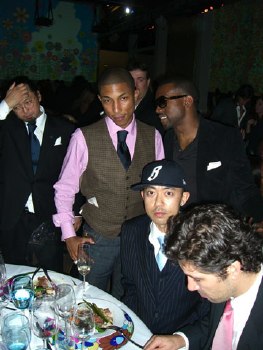 Murakami is an example of an artist engaging directly with elements of the gala. In addition to decorating the tent with the same flowered wallpaper used in the galleries, each place setting had a matching Kaikai Kiki placemat for a gift/party favor. [right, image of TM, Pharrell, Kanye, Nigo and placemat, and white guy, via bbc (2019 updated link to archive.org] When, during the dancing, Naomi Campbell, egged on by Tom Ford, began gathering up a set of twelve from unattended seats, a black-tie placemat riot broke out. [The frenzy was repeated at the show’s Brooklyn Museum incarnation, with the role of placemat-hoarding diva played by Borough president Marty Markowitz’s wife.]
Murakami is an example of an artist engaging directly with elements of the gala. In addition to decorating the tent with the same flowered wallpaper used in the galleries, each place setting had a matching Kaikai Kiki placemat for a gift/party favor. [right, image of TM, Pharrell, Kanye, Nigo and placemat, and white guy, via bbc (2019 updated link to archive.org] When, during the dancing, Naomi Campbell, egged on by Tom Ford, began gathering up a set of twelve from unattended seats, a black-tie placemat riot broke out. [The frenzy was repeated at the show’s Brooklyn Museum incarnation, with the role of placemat-hoarding diva played by Borough president Marty Markowitz’s wife.]
For the closing gala for The Artist Is Present, Marina Abramovic provided both a participatory/performative experience and an object/edition. For dessert, guests received edible gold leaf to apply to their lips, so they’d match their little replica of Marina’s lips, cast in dark chocolate & gold leaf by the “food-as-art” specialists at Kreemart.
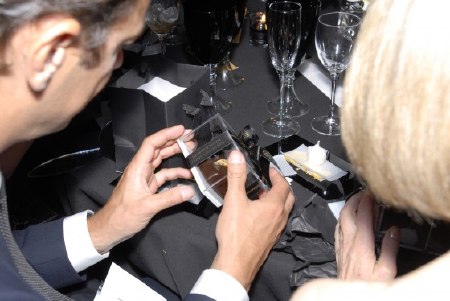
[image, one among many at whitewallmag.com]
And performance is an important vector here. In 2006, Lali [now Spartacus] Chetwynd restaged the 1931 Beaux Arts Ball as a costumed conversation within Rem Koolhaas’s inflatable Serpentine Pavilion [below].
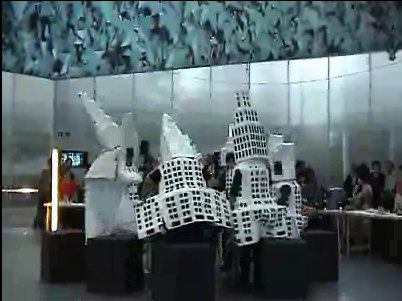
Any Hamptons summerer will know, or at least know of, Robert Wilson’s annual Watermill Arts Center Gala, an art event which has been critically overlooked for years, either because it’s summer, and critics are off the clock, or because it’s just theater, or just Wilson’s eccentricity, or just whimsy or a sideshow, and why bother?
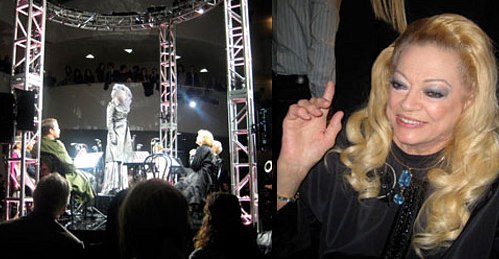
But Wilson is an old hand. If there’s a leading gala art artist, at least until Aitken’s arrival, it’s probably Francesco Vezzoli. In 2007 Vezzoli infuriatingly upended museum VIP convention when he taped–with Doug Aitken’s DP, apparently–a reading of a Pirandello play in the Guggenheim. Not that anyone paid attention to the play, of course; accounts of the event almost all focused on the interminable delays, the impatient walkouts, and the seemingly arbitrary door policy that left boldface names standing in line for hours. It’s still not clear whether that was all intentional–or even the entire point. And if it was, it’s not clear that the audience was sufficiently appreciative of the brutal experiential buzzkill that Vezzoli’s work induced. Or maybe it’s just a New York thing.
New York’s gala art does seem to have more of an edge. Consider the work by gala art’s rising star, Jennifer Rubell. It’s worth noting that, while they are extremely active as collectors, the Rubells have never been voracious gala-goers. So the gluttonous orgies of food and drink Rubell has staged for Performa 09 and the Brooklyn Museum’s Late Warhol show have a bit of a joke’s-on-them, catering-as-institutional-critique feel about them.
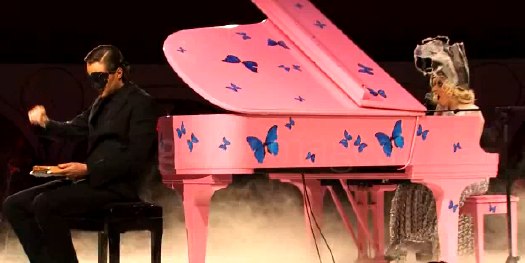
[via]
Last year Vezzoli produced the entertainment portion of MoCA’s Gala. The Bolshoi danced while a masked Vezzoli sat mime-embroidering in front of Lady Gaga, wearing a Frank Gehry hat, playing a Damien Hirst butterfly piano. Which certainly looked enough like art to bring $450,000 at the Gala’s auction. And all this before Deitch came to town.
So what’s different now? I see three things that alter the context of MoCA’s Gala this year: Aitken’s intervening in the entire event, and he’s demanded there be “no compromise to his artistic integrity.” And Aitken is not calling the Gala a gala, but a Happening, which, wow. And for his part, Deitch pulls out the rhetorical stops, describing the project as the pinnacle of Aitken’s career, “not just a Happening, but an artwork that pulls together elements of everything you’ve done.”
Besides Aitken’s seeming ambivalence at Deitch’s showman’s patter, I think my favorite moment in his Malibu speech is when he tries to rally his polite, checkwriting crowd to his cause: “We’re hijacking the Gala,” he cries, “and turning it into a Happening.”
Beat.
“And I hope everyone in this room is with us.”
Beat.
“No more galas! Let’s bring it back. Let’s bring it back–someplace.”
And so on the one hand, we have a Happening being staged as a $4 million gathering of celebrities and billionaires, with the intent, it seems, to create some “moments that are filled with content,” and “the immediacy of pure conversation.” With Devendra Banhart. And possibly Franz West on the drum table. Also an artist’s book. Perhaps it’s a return to the art-for-and-with-artists ethos of the Happenings as they were conceived by folks like Allan Kaprow.
But Deitch sees a bigger picture:
JD: maybe you should talk about the Happening, because it has become.
Not just a Happening, but an artwork that pulls together elements of everything you’ve done.
DA: Yeah, yeah.
JD: So the film work, the music work, operatic work,
DA: Yeah i do think–I’m glad Jeffrey reined me in a bit here, so we can–
JD: First, this has been just. Extraordinary.
[applause]
JD: What a remarkable body of work. You told me once about how it started in this windowless loft on Broadway New York. [? -ed.]
DA: Yeah, yeah.
JD: And this is an amazing artistic journey from that windowless loft, where you were making sculpture,
to a whole new way to make a work of art.
This key word is “immersive,” where the viewer is really part of the experience, and doesn’t just look at the work, but FEELS the work, is INSIDE the work.
And that’s a good way to get into what we’re talking about with the Happening.
Because there’ll be one thousand of us.
Inside this work.
Now that’s a journey. Someplace, it seems, is right inside, with us.
